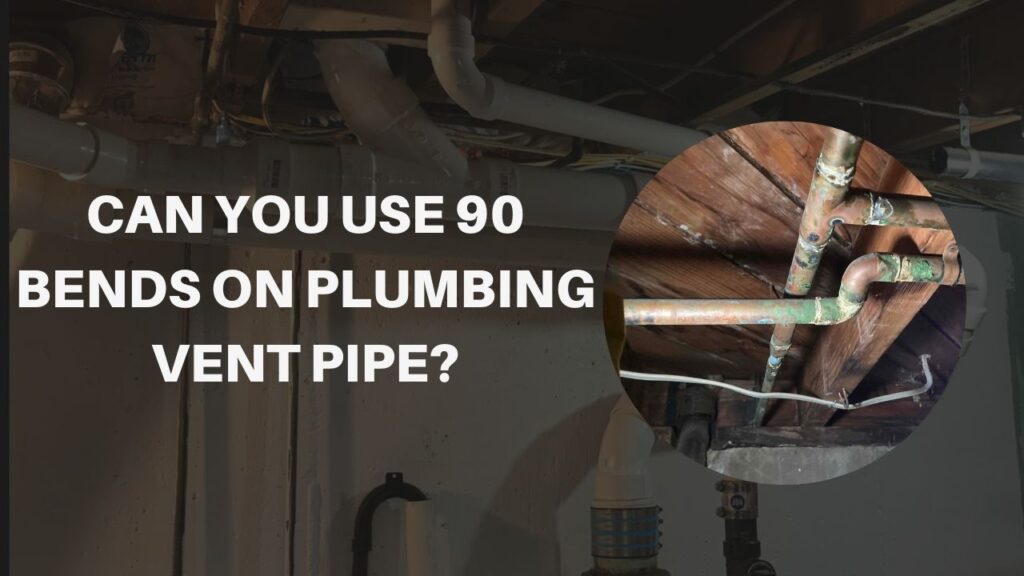Can You Use 90 Bends on Plumbing Vent Pipe? When installing a plumbing vent system, proper pipe configuration is essential for effective drainage and preventing sewer gases from entering your home. A common question is whether you can use 90-degree bends (elbows) in a plumbing vent pipe.
The answer depends on plumbing codes, airflow efficiency, and the overall design of your plumbing system. Understanding these factors will help ensure your venting system functions properly and meets regulatory requirements.
Can You Use 90-Degree Bends on a Vent Pipe?

Yes, you can use 90-degree bends in a plumbing vent, but there are important factors to consider:
1. Airflow Considerations
Unlike waste ducts, which rely on gravity for waste removal, vents primarily allow air to pass through. A sharp 90-degree bend can reduce the velocity of airflow, which can lead to:
- Reduced ventilation efficiency.
- Increased risk of clogging if debris builds up in the bend.
2. Plumbing Code Restrictions
Most building codes allow 90-degree bends in vents, but with some limitations. Common requirements include:
Horizontal Vent: A 90-degree elbow is generally acceptable when transitioning between vertical and horizontal sections.
Vertical Vent: A straight run is preferred for optimal airflow, but a 90-degree bend can be used if necessary.
Chimney Venting: Avoid multiple sharp bends, as they can restrict proper ventilation.
3. Alternate bends for better airflow
If possible, use two 45-degree bends instead of a single 90-degree bend to create a smoother transition and reduce resistance in the venting system.
Read Also: How to Remove Mold Sling from Kitchen Sink
Vent Stack in Plumbing Systems: An Introduction
In plumbing systems, vents play a critical role in maintaining the integrity and functionality of the overall system. Typically extending from the drainage system to the outdoors, these vertical pipes serve a crucial function in ensuring the even flow of waste and preventing unpleasant odors or harmful gases from entering living or working spaces.
The primary function of a vent is to provide a pathway for the release of sewer gases and equalize air pressure within the plumbing system. By allowing air to enter the drainage system, vents facilitate the proper flow of water through the pipes and prevent the formation of voids or siphon effects that could impede drainage.
Additionally, vents help prevent blockages in pipes and promote efficient drainage by reducing the chances of wastewater backing up or becoming trapped. Including bends or turns in vent ducts, such as the commonly used 90-degree bends, allows for flexibility in pipe routing while maintaining effective airflow.
It is essential to adhere to established codes and standards, such as the International Plumbing Code, the National Standard Plumbing Code, and the Uniform Plumbing Code, when designing and installing vent ducts. These codes outline the guidelines and regulations necessary to ensure the safety, functionality, and longevity of the plumbing system.
In conclusion, vent ducts are critical components of plumbing systems, providing necessary ventilation, preventing blockages, and maintaining a healthy and efficient drainage system. By understanding the importance of proper ventilation and adhering to plumbing codes, professionals and homeowners can ensure optimal performance of their plumbing systems.
Understanding Vent Pipes
Vent pipes play a crucial role in keeping your plumbing system functioning properly. They allow air to enter the plumbing system, which prevents vacuum pockets that can cause slow drains or water traps. Vent pipes also release sewer gases and help maintain proper pressure within the plumbing system.
The Role of Bends in Vent Ducts
Bends in vent ducts are necessary to navigate around obstacles and fit into a building’s design. However, not all bends are created equal. The angle and frequency of bends can significantly affect the performance of the ventilation system.
Also Read: Can Plumbing Drain Go into Toilet Vent?
Using 90-Degree Bends
While 90-degree bends are permitted and widely used in vent ducts, there are some considerations to keep in mind:
Reduced Airflow – Tight bends can create resistance, reducing the amount of air that can flow through the vent duct. This can lead to inadequate ventilation and potential problems with water traps and drainage.
Water traps: In some cases, water can collect in the bend, creating a trap that prevents air from flowing freely. This can exacerbate ventilation problems and potentially lead to blockages.
Noise: 90-degree bends can cause noise as air rushes through the sharp bend, creating gurgling or hissing sounds in the plumbing system.
Best Practices for Using 90-Degree Bends
While 90-degree bends aren’t ideal for plumbing vent pipes, there are situations where they may be necessary. If you must use them, follow these best practices to avoid potential issues:
Minimize the Number of Bends – Use 90-degree bends only when absolutely necessary. Whenever possible, opt for 45-degree bends or long sweeps to improve airflow.
Maintain Proper Slope – Ensure the vent pipe has a consistent slope to prevent water buildup and allow proper drainage.
Install Cleanouts – Place cleanouts near 90-degree bends to make maintenance and blockage removal easier.
Follow Local Codes – Always check local plumbing codes, as some areas have specific rules about using 90-degree bends in vent pipes.
By following these guidelines, you can ensure your venting system remains efficient and compliant with regulations.
Conclusion
While you can use 90-degree bends in plumbing vent pipes, it’s important to be aware of the potential problems they can cause. By following best practices and adhering to local plumbing codes, you can ensure that your vent system operates effectively and efficiently.
Related Articles:
How to Connect Water to a Utility Sink Without Plumbing
